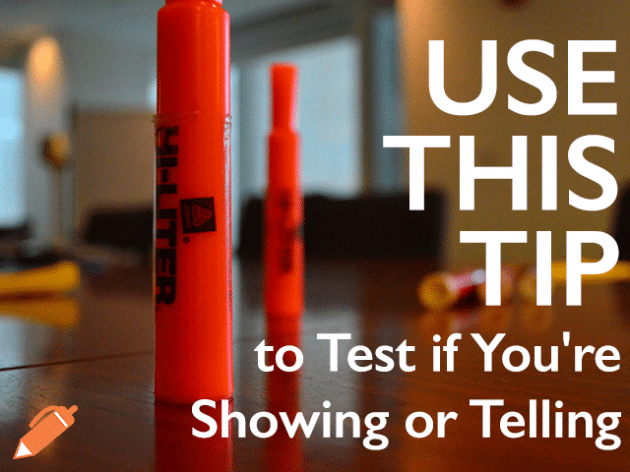We’ve all heard a variation of the advice: show, don't tell. In other words, don’t tell us what happened, show us. In fact, you've even heard “Show, Don't Tell” on The Write Practice. The idea is that through descriptive phrase we can provide a better experience for the reader and provide them with the opportunity to make her own interpretations.
Ok, so you’ve done that. You've completed a piece and tried your hardest to avoid telling. But how do you know you’ve succeeded?
Well first, check this post for the specifics on how to write vivid descriptions with examples of “show, don't tell” best practices.
A Tip To Check Whether You're Showing or Telling
Then, after doing your best, try this tip that I learned at The Writer’s Center in Bethesda, Maryland.:
Go through your manuscript and highlight every time you see an adjective (beautiful, lazy, persistent). Or a feeling (love, hate, frustrated). If you see too many highlighted words, consider revising.
How can you convey these adjectives or feelings to the reader without using those specific words? What can you do to guide your reader?
PRACTICE
Practice your showing skills! Write a paragraph using descriptive detail. Now, see how many adjectives/feelings you've used. Take a few minutes to revise and share with us below!








Oh I used to work at The Writers Center! Such a great place 🙂 And a great tip for showing vs telling!
Yes, indeed. When I hear someone say, “It was fantastic!” I always want to hear the details so it’s me who shouts, “Fantastic!” The reader should be shouting, “Fantastic!” Not the writer.
So true
Section from my WIP – the two main characters are meeting for the first time. Tried to convey that awkwardness of trying to talk to someone you don’t know. Let me know if it worked 🙂
Never seen a teenager do the handshake thing before. Not with other kids anyway. But I tucked June under one arm and shook her hand. She had a firm grip for someone who was so thin.
“I’ll try to keep her out of your way,” I said, indicating the now limp cat in my arm. “I really am so sorry about that, I-“
Alicia quirked the corner of her mouth. “It’s fine, really.” She gestured to June. “What’s her name?”
“Juniper. What’s your dog’s?”
“Sedgwick.”
“Sedgwick? That’s…unusual.”
She ruffled the dog’s hair affectionately. “Named for John Sedgwick, Civil War general.” She noticed that I still looked confused. “It’s a rather long story.”
“Oh.” Awkward points were increasing rapidly. “Um, where are you moving from?”
“Braxton. My mum has a new job and it’s much closer to here than our old house.”
“What does she do?”
“Pediatrician. She’s switched to a different practice.”
“Oh, cool.”
Silence. June squinted at me and meowed, whining.
“Alicia! Would you bring the dog inside and help me with these boxes please?”
Alicia gestured over her shoulder. “That’s my mum. I ought to go help her. But we’ll be seeing more of each other I think,” she said, with that quirk in her mouth. I realized that it meant she was amused.
“Yeah. Well, bye!” Alicia walked away, pulling Sedgwick behind her. I watched her disappear into the house. I wasn’t sure if I was relieved or disappointed.
You have successfully showed us that teenage awkwardness. It’s excruciating and endearing. Will be interesting to see where this goes!
I really liked it! It was cute how Alicia was a little more confident than the main character. And yes I saw the awkwardness, but it was a cute kind of awkwardness. I’d love to hear more.
Title of my paragraph: The Long Gone. It is not adverb-free, and I am not sorry!!!!
Our fiscally broke little town held a public cemetery clean-up the other day, and I was one of several hundred volunteers who sacrificed Saturday morning to pull weeds and rake debris. After several hours, the high desert sun was bleaching my bones through the skin. I had cool water, and wanted to sit in some shade. The only trees on this wind-swept hillside were 100 yards west of the cemetery, so I trudged through the dust to get there. Once there, I discovered this was actually a burial ground too. Under three ancient cottonwoods, was a square roughly 25 x 25 yards, and inside that area, simple wooden headboards and tombstones. There were no markings left, if any had been there. The tombstones were crumbling sandstone, not marble. Who were these people? Among the grave markers were two bronze flagstones, boldly engraved “Spanish American War”, and each bore the name and number of a regiment. No names though, to identify the deceased. The flagstones were an important clue, as that particular war lasted only three months, in 1898. Looking at our little cemetery, the older graves are to the south, with the newer ones in the northerly sections. I recalled, from the cleanup I’d just completed in the old section, that the 1890’s were nearly a quarter mile away. So when these people were buried here, they were not only outside the cemetery, but very far away from it. Outcasts. From the little I know of that era, these would be prostitutes, non-whites, card cheats, murderers, anyone shameful enough through birth or behavior to be regarded as subhuman. I can’t really call these people “forgotten”. To be forgotten presumes you were once known. People once knew your name, and knew who you were, and missed you when you were gone. The “forgotten” were back in the old section I’d just worked in. They were forgotten, and those who knew them are forgotten, except that they all have nice marble gravestones that still bear crisp engravings of names, dates, titles, and relationships. Their existence is verified and validated. Ironically, I do know a little about cottonwood trees. Their average lifespan is 70-100 years. The trees casting the deep, nurturing shade over my rediscovered rejects are half dead. I suspect they weren’t there when this square plot was used as the local human dump. Without the trees this would be a particularly harsh, exposed flank of the mountain. I’m happy that, 120 years later, this is prime real estate, the prettiest, most serene resting spot I’ve ever seen. I’m sure some of these people did something that gave their fellow citizens good reason to excommunicate them from our species. However, I suspect most of them did nothing worse than being born, or perhaps doing what they had to do to survive. And the two soldiers, what circumstances led to this result, that they are buried with that society’s offal? Their names are not on their gravestones, yet they must have been known, as their regiments and war service are duly recorded. Maybe the only decent thing those two ever did? Who knows? As I can’t call them the “forgotten”, I think of them as “The Long Gone”. They were here; few if any really knew them beyond their labels: “whore”, “Chinaman” (Chinese immigrants built the railroad through this town), “rustler”, “claim jumper”. They were here, and now they’re gone, and just a few crumbling pieces of wood and rock commemorate their brief sentient incarnation in the Wild West. That’s all Long Gone, and so are they.
Great writing, Avril. You give a very clear and descriptive account of not only the scene but what was the way people thought over 100 years ago. Many still think the same way now.
Adelaide
Sad but true Adelaide. Thank you for your kind comments.
Wow, Avril, I love it!
On a lovely spring afternoon, you left me. The sun’s rays beamed in your direction, highlighting your spiny, unshaven cheek – the kind of cheek that I loved to run my fingers through. I stared into your green eyes… I held your hand and embraced you for the last time. You kissed me gently on the head and then you drove off and left me alone.
And I remember parking myself on the park bench… in disbelief that on such a beautiful idyllic day, you left me alone to cry. I got so used to crying in your presence, so used to your warm embrace. Hot tears were always accompanied by tender love, by warmth, by tissues… this time, you saw your lady weep – and you left her.
Martha checked her appearance again in the hall mirror. Hair in place, makeup just right, suitable dark suit. Yes. She was ready. No she wasn’t. She ran back upstairs and
rummaged through her jewelry box. Her grandmother’s lapel watch for luck. She
pinned in on and removed the watch from her wrist. It would look silly to have two watches. But it was awkward reading the label watch. Oh…She put the wrist watch in her purse. Then pulled it out again and checked the time. She was going to be late. The final interview and she was going to be late.
“Bye Mom,” she called as she ran down the stairs. “Got to hurry.”
“Good heaven, Marty. It’s only nine. You don’t need an hour to get there. It’s a twenty minute drive.”
“Yeah, I know, but… Wish me luck.”
“Of course. Lots of luck. And drive carefully. You have plenty of time.”
Yes, drive carefully. No tickets, no accident. What if traffic was heavy? All those school buses going so slowly, stopping at every corner. No. It was past the time for school buses.
It was nine-thirty when Martha arrived at the Connolly Building. She read the directory although she knew the floor and the room number. Sixth floor, room 605. Sixth floor, room 605.
Go up now. No. Wait ten…no fifteen minutes…then go up. A little early look good, responsible. Too early looks anxious. She looked at her reflection in the glass door, straightened her posture and waited.
My goodness, this sounds just like me when I’m going to an interview! I always have to be way early! You wrote Martha and her actions very realistically. I especially liked when she couldn’t make up her mind about the watch. Also, the way you repeated the phrase “sixth floor, room 605. Sixth floor, room 605,” and the short sentences in a row “Yes, drive carefully. No tickets, no accident. What if traffic was heavy?” conveyed–showed *wink wink*–that she was nervous. Really great job!
Thank you. I’m glad her nervousness came across.
Adelaide
Were her thoughts in italics in the initial piece? If not, I am wondering why you chose not to do that? Just curious as I have my protagonists thoughts in italics. When the editor did the sample edit, he was o.k. with that but felt that the Spanish words might not need to be in italics after I use them the first time. He also said I didn’t need italics for emphasis, that the reader would get it.
Here’s an example: “Dalton is definitely not a Salvadoran name so I may have
gotten treated better by students and teachers alike if I had only had that
name.”
OK, the words didn’t italicize here. I had “Dalton” in italics & “not” too. The editor hasn’t checked this yet, but he would probably recommend the name be in quotes and to just leave “not.” He says we have to trust the reader to get the emphasis.
I am very curious what others think about this as I am really using too many italics.
I never put a character’s thoughts in italics. The reader will know that these are the charactere’s thoughts. In many of my stories I depend on the character’s thoughts to give insight into the character’s mind and personality. If I were to put them in italics much of the story would be that way.
I don’t think you need to put Dalton in italics or the word not. If you have an editor making suggestions to follow a style he likes, then I guess I would follow his suggestions.
I jumped at the chance to do this exercise because I’ve been trying really hard not to lean on unnecessary adjectives and especially feelings. The first paragraph may seem a little bulky and rushed because I started up in the middle of the scene, so I summarized what’s going on in the beginning so the rest of the scene makes sense.
—
The bustle of Rosewood café continued, and Julia shut her eyes and relaxed in she and Rouge’s booth. Sean had not seen her and he had left.
“We have to tell Shadow I saw Sean,” she said to Rouge.
Rouge lifted her wrist and spoke into the comm device. “Shadow, we need to meet you ASAP. Julia identified someone who’s looking for her.”
Static filled the air, then Shadow’s voice said, “Meet me at Rosewood Café.”
“We’re already here.”
“Wait for me there and radio me again if something else happens. Shadow out.”
The two of them remained at their booth. Julia’s throat was still dry, so she sipped some of
her Sprite.
“So who exactly is this Sean guy?” Rouge asked, watching Julia from across the table.
Julia avoided her friend’s eyes. “Not someone you want against you.”
Shadow strode in minutes later. He approached their booth with a deep frown. “I need a
description.”
“He’s about five foot ten and he’s got short, light hair, and dark eyes.” Her throat convulsed at the thought of those cold eyes.
Shadow scribbled it down on a napkin and clenched it in his fist. “Let’s go,” he said to Julia.
“I’m taking you home.” He shifted to Rouge. “Stay here and keep a look out in case he comes back.”
She offered a mock salute and smirked. “Roger.”
“Come on, Julia,” Shadow said. He extended his hand and helped her out of the booth. With one last look at Rouge, Julia followed Shadow out of the café.
—
Julia didn’t relax until they were a mile out of town. “That was too close,” she said as she and Shadow plodded through thick beds of dead leaves.
“There’s something you’re not telling me about this Sean.” Shadow’s voice was low.
Heat seared her cheeks. “I told you. He’s a mean soldier that works for the guy who kidnapped me.” She quickened her pace.
Shadow caught her arm and made her stop in the middle of the path. “No. Whenever someone brings Sean up, you shrink into yourself.” His eyes were hard. “Now explain.”
“He…” She pulled away and started walking again. “He was just rough with me.”
Shadow came up beside her. “Describe ‘rough.’”
“He just…you know, yanked me around.” That part was true. She glanced at Shadow. He studied her face without blinking. She looked away and said, “I don’t like to talk about it, okay?”
“Did he rape you?”
Her feet froze on the ground. Bile churned in her stomach as memories swept over her. How Sean slammed her up against the wall. How he slung her into the floor and pinned
her, bruising her shoulders in an attempt to keep her there.
She sucked in a breath and blocked out the rest of it, covering her face in her hands as she sank to her knees and sobbed.
Shadow’s arms came around her, holding her tight.
—
I’d love comments/ critique, but especially were the characters consistent? Did the scenes flow well? Was there anything that seemed out of place? What is your judgement of Julia’s personality and her as a character?
Thanks! : )
I thought the characters were very consistent. I got the sense of a team dynamic in this excerpt, which is always something I like in books, movies or anything. I am also partial to gruff-but-kind-kickass-detectives/spies, which is to say I like Shadow a lot already. I am definitely interested to know more about Julia and her role in this story. She’s intriguing. Keep going with this for sure 🙂
Thank you so much. You’re awesome! : )
Yes, from this small selection, I think your characters are consistent. Julia is scared and reluctant to talk; Shadow is a “take charge” person and cares about Julia.
Keep writing.
Adelaide
Thanks, Adelaide!
There is a good book on this topic by James Thayer titled Show or Tell.
I LOVE this! Great tip! 😀
I think the keys to “telling” are being specific and also painting vivid imagery.
So instead of “He was lazy”, go “He was at times lying in his hammock for hours, just staring at the wide blue sky and enjoying the calm.” Now you were more specific while also being more visual. This makes your writing sound and feel more like a story.
Of course, consider length. You don’t want to bore anyone to death! 😉